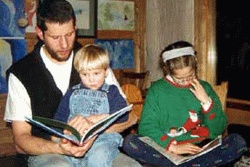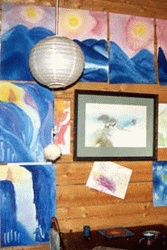"Especially as a teacher, I believe very strongly in the full development of a child -- in balance -- and Dorn and I are both a little too intellectual in our thought processes, so it was a worry for me to begin home schooling because I knew it would be hard for me to not have intellectual expectations … it still is. I want their bodies to develop, not just their heads, you know," says Diane. But with an emphasis on art in the home, and a theme of unification to the Waldorf method of teaching, the Van Dommelens manage to achieve a sense of balance between home life and schoolwork, even though both occur in the same space.
A Waldorf education is designed to be experiential, and is taught in blocks, or "intense units." Dorn explains, "The thing that's nice about Waldorf -- whether it's home school or in the school -- is there's a theme, there's a thesis to it, there's this idea that unifies everything. It's not just arbitrary." For example, when the children studied the math blocks, "every morning we would read a story about a famous mathematician, followed by writing a small little piece about what they took out of that," Dorn says.
 |
| Dorn, Robin and Eve |
 |
A "Greek block" means not only studying and writing about the Greek gods and mythology, but also incorporating a Greek feast, complete with lentil stew and meditation. "In the fifth grade they learn history through stories," Diane says. "Eve, for example, is doing a lot with Greek culture, but this year her literature proper is Greek myths, so she's studying them as literature, and the other myths she was studying coincide with the history of the culture, so they overlap."
"Lang had composition, which was perfect for reading and writing about great literature," says Diane, "He has proper history blocks, so he wrote an out-take of what we read on one side, and then some kind of inspired composition on the other side. Right now he is doing a self-directed Renaissance block. He said, ‘please, let's do history!' and he also wanted to explore the self-directed aspect."
Lang wanted to take on his own project, so a lot of the challenge is figuring out how to do that. He's had reports before but not a whole block where he just read books and writes essays. Diane says that he's written some thought-provoking essays, which is a big step for him. Lang is able to read something and tell his parents what it said word for word verbally, giving an oral presentation, but he has had trouble writing things down.
"It's one thing to read and tell what something says, it's another thing to process it and interpret it. So, I think it's going well, says Diane. "There're some struggles. It's hard work. It's hard to write, especially when you're thirteen. We're saying, here are some books, answer these questions -- you know, ‘what is a Renaissance man?'
We're on the fourth draft of one of these essays, with lots of red ink still being spilt on them, which is good, but it's hard. But, it's better he learn it now than when he's 19."
Emphasizing Art
 |
| Wall art at the Van Dommelens' home. |
 |
Artistic representation is important in the Waldorf School, and the Van Dommelens tend to over-emphasize art in their family, since it is connected to "feelings and emotions" in the Waldorf philosophy. Painting is a regular activity around their house, and most recently, Lang has been taking classes from Peter Brondz, a local potter, twice a week. Diane adds, "Peter's a really strict teacher, so it really ... it's not just for fun."
This emphasis on art doesn't worry Diane and Dorn. "I'm very much a believer in liberal studies. If Lang decided never to go to college, to become a production potter, I'd be happy with that," says Dorn.
Music is also an important part of the kids' learning. Eve plays the accordion and Lang plays the guitar. They often play bluegrass music together, and have even played some public shows, including the Waldorf School's harvest fair and for Peter Brondz's gallery show.
But their artistic sides don't stop there. Diane says, "They also knit, quilt, paint …"




